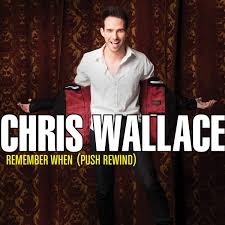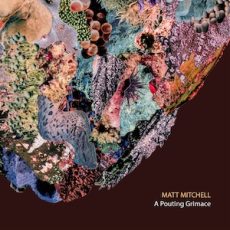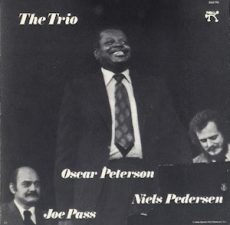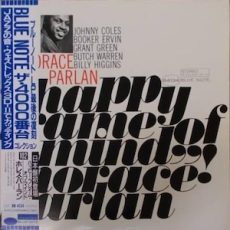
Requisites
Monty Alexander In Tokyo | By Eddie Carter
I first heard Monty Alexander In Tokyo (Pablo Records 2310-836) in 1985 at the former jazz station, WNOP 740 AM, after my move to Cincinnati from Cleveland, Ohio. It was recorded during the pianist’s first trip to the city and is his nineteenth release as a leader. Here, he is working with two of the best in the business: Andy Simpkins on bass and Frank Gant on drums. My copy is the 1979 U.S. Stereo pressing, and the trio opens this musical adventure with a trip to Broadway by Billy Byrd, Teddy McRae and Henri Woode. They begin this catchy tune with a delightfully crafted melody. Monty cuts loose in a spirited statement that’s sure to have your fingers popping and toes tapping along until the song’s conclusion.
Just In Time by Jule Styne, Betty Comden, and Adolph Green starts with a short introduction by Monty, segueing into the threesome’s pulsating theme, who treats the standard like an old friend. Monty comes alive in the song’s only interpretation ahead of the closing chorus and finish. Sweet Lady is a lovely ballad by Dave Zoob, Frank Crumit, and Howard E. Johnson. It’s a showcase for Monty and Andy, who start the song with a tender introduction that leads to their enchanting melody. The duo sustains the gentle mood in the delicately sensitive statement they share, preceding a polite reprise and climax.
Tricotism by Oscar Pettiford begins with the trio introducing this happy swinger collectively before taking the theme at a fast clip. Monty kicks off the solos with a scintillating opening statement; then Andy takes over for a bit of brisk walking. The pianist has a second interlude before Frank engages in a short workout ahead of the melody’s restatement and ending. Never Let Me Go by Jay Livingston, and Ray opens with the threesome’s slow-tempo introduction. The pace picks up to a medium beat for the opening chorus, ahead of the pianist’s driving solo that has something to say into the closing chorus.
Up next is Montevideo by Richard Evans, which takes off from the opening notes of the trio’s upbeat introduction and melody. The rhythm section spurs Monty to soar into the stratosphere in the song’s only statement until he returns to Earth for the theme’s reprise and abrupt ending. Pawnbroker by Quincy Jones is a very pretty ballad from the 1964 film drama. It’s a solo showcase for Monty Alexander, and the pianist uses the poignant melody effectively to depict the song’s sincerity and melodic beauty in a gorgeous interpretation, preceding the melody restatement and a lovely summation.
See See Rider by Ma Rainey brings the album to a close on an upbeat note. The trio starts expressing their joy and pleasure in the melody. Monty is up first with an especially impressive interpretation; then Andy takes a short walk through the second reading. The pianist puts the finishing touches on the song ahead of the closing chorus and ending. Monty Alexander produced Monty Alexander In Tokyo, and Katsuyuki Handa and Kazutoyo Takeda were the recording engineers. The sound quality is excellent, with a vivid soundstage that transports the trio to your listening room’s sweet spot.
Whether you’re new to Monty Alexander’s music or a seasoned fan, Monty Alexander In Tokyo is a versatile album that’s perfect for any occasion. It’s the perfect soundtrack for a relaxing evening or a lively dinner with friends. I highly recommend adding it to your jazz library. With its diverse range of tracks, it’s a testament to the trio’s musical prowess and a must-have for anyone who loves a piano trio!
~ Just In Time – Source: JazzStandards.com
~ Broadway, See See Rider – Source: Wikipedia.org
© 2024 by Edward Thomas Carter
More Posts: choice,classic,collectible,collector,history,instrumental,jazz,music,piano

Daily Dose Of Jazz…
Chris Wallace was born on August 9, 1971 in Regina, Saskatchewan. A self taught drummer he rose to professional status through relentless self study. As he developed as a musician he began to add jazz music to his already large repertoire of pop, rock, r&b and funk. He moved to New York City and studied with drum clinician and educator Dom Famularo.
In the late 90s he relocated to the United Kingdom and became a central figure in the jazz scene in Scotland. He put together two trios, NeWt which was awarded the 2012 Scottish Jazz Ensemble, and Breach, and he formed a quartet named Loose Grip that released the album Looking Glass. Wallace has appeared with countless international jazz musicians as a sideman.
Becoming more active on the jazz scene, he began performing with many of the nation’s top players such as Graeme Stephen, Paul Harrison, Phil Bancroft, Steve Hamilton, Kevin Mackenzie, Mario Caribe and many others. As a sideman he performed with international artists such as Jamie Oehlers, Jim Mullen, Silke Eberhard, Alan Barnes, Louis Durra, Damon Brown, Ulf Wakenius, Anders Bergkrantz and others.
Chris has backed many singers as well including Lady Rizo, Ali McGregor, Julienne Taylor, Lillian Boutee, Niki King and Holly Penfield. Not limiting himself to jazz, the rock field has Chris sharing stages across Europe with bands such as Asia, King Crimson, Uriah Heep, Saga and many others. He has performed with world class cabaret artists in the UK and has toured Australia twice.
As an educator he has a long teaching history as well, with many years of private students of all ages under his belt. More formally, he was head drum tutor at Stevenson College in Edinburgh, Scotland for three years beginning in 2009.
Drummer Chris Wallace, now based in Toronto, Canada, continues to perform and record.
More Posts: bandleader,drums,history,instrumental,jazz,music

Daily Dose Of Jazz…
Matthew Mitchell was born July 19, 1975 and grew up in Exton, Pennsylvania. He first played the piano aged six, and composed from the age of 10. He had lessons in jazz and theory at a university from the age of twelve and at this stage he was influenced by pianists Keith Jarrett and Herbie Hancock.
He attended Indiana University for three years and then completed a master’s degree at the Eastman School of Music in the late Nineties before settlling in New York City. After holding down several jobs in the city Matt decided to move to Philadelphia, Pennsylvania where he worked in a library at The University of the Arts for nine years before leaving when he had too many gigs to fit in.
2011 saw him leading the sextet Central Chain, the following year he introduced a new trio with bassist Chris Tordini and Dan Weiss on drums. During this decade Mitchell was also part of Berne’s Snakeoil band, and John Hollenbeck’s Large Ensemble and Claudia Quintet. He joined and recorded with saxophonist Rudresh Mahanthappa’s band.
Mitchell was awarded a Pew Fellowships in the Arts in 2012. He has released fifteen albums as a leader or co-leader and recorded as a sideman on thirty albums.
Pianist and composer Matt Mitchell, who is a faculty member at New York’s Center for Improvisational Music, continues to expand his jazz catalogue through performance, composition and recordings.
More Posts: composer,educator,history,instrumental,jazz,music,piano

Requisites
The Trio ~ The Oscar Peterson Trio | By Eddie Carter
This morning’s record from the library is a live album featuring three jazz giants. The Trio (Pablo Records 2310 701) is aptly named because it captures Oscar Peterson on piano, Joe Pass on guitar, and Niels-Henning Ørsted Pedersen on bass in performance during three nights at the Chicago jazz club, London House. What makes this album unique is the exceptional chemistry between each musician. Oscar Peterson’s virtuosic piano playing, Joe Pass’s innovative guitar techniques, and Niels-Henning Ørsted Pedersen’s melodic bass lines all shine through in this album. My copy is the 1973 U.S. Stereo release.
Side One starts with the first of two tunes by Oscar Peterson. Blues Etude begins at a brisk clip, with Joe and Niels-Henning firing on all cylinders before Oscar joins them for the melody. Oscar reveals his broad range in the song’s only solo, enhanced by Joe and Niels-Henning’s accompaniment. Chicago Blues is a delicious dish of soul food beginning with a lengthy piano introduction ahead of the trio’s slow-paced melody. Oscar opens with a tasty invitation for everyone to come to the table. Joe takes charge with a delicious second course next. Oscar adds another scrumptious dish to the meal, and then Niels-Henning provides the final course with a succulent solo preceding a luscious ending.
Side Two opens with Easy Listening Blues by Nadine Robinson. The trio gets things started with a polite melody. Oscar begins the song’s only solo with a warm caress of the keys, creating a beautiful musical landscape. Meanwhile, Joe and Niels-Henning tail him closely until the theme’s restatement and conclusion. Come Sunday is a beautiful jazz standard by Duke Ellington that becomes the sole showcase of Joe Pass. The guitarist approaches the theme and song’s only solo with a simple directness, resulting in a wonderful expression of incredible beauty culminating with a tender ending and appreciative applause from the audience.
Secret Love by Sammy Fain and Paul Francis Webster is a lively tune that will have you tapping your toes from the trio’s opening ensemble. Oscar is up first with a happy groove that makes a lasting impression on the listener. Joe steps up next and gives a splendid statement; then Oscar adds a few final comments ahead of the theme’s reprise and the audience’s approval. Norman Granz produced The Trio, and it’s unknown who supervised the live recording. However, the album’s sound quality is excellent with a soundstage that transports the listener to the London House audience as the trio is performing.
If you’re discovering the music of Oscar Peterson and are in the mood for a live album where you become part of the live audience at the London House. I invite you to check out The Trio by The Oscar Peterson Trio the next time you visit your favorite record store. It’s a fantastic album that captures three of the most renowned musicians at the top of their game. The Trio is a title highly recommended for a spot in your library, as it not only showcases the individual brilliance of each musician but also their exceptional chemistry, making it a must-have for any jazz enthusiast!
~ Come Sunday – Source: JazzStandards.com
~ Secret Love – Source: Wikipedia.org
© 2024 by Edward Thomas Carter
More Posts: bass,choice,classic,collectible,collector,guitar,history,instrumental,jazz,music,piano

Requisites
Happy Frame of Mind ~ Horace Parlan | By Eddie Carter
Horace Parlan has always been one of my favorite pianists, and this morning’s record from the library is a 1963 recording session that remained shelved until 1976. Happy Frame of Mind (Blue Note BST 84134) is a sextet date that was initially released as a two-record set by Booker Ervin. It finally hit the stores a decade later with its original cover and catalog number. The supporting cast is a stellar one: Johnny Coles on trumpet, Booker Ervin on tenor sax, Grant Green on guitar, Butch Warren on bass, and Billy Higgins on drums. My copy is the 1991 Toshiba EMI Japanese Stereo reissue sharing the original catalog number.
Side One opens with Home Is Africa by Ronnie Boykins. Butch and Billy get things started ahead of the ensemble’s haunting melody. Johnny is up first with a relaxing reading; then Booker gives a gorgeous solo. Grant makes an effective contribution next. Horace gives the song’s most inventive improvisation before the sextet’s closing chorus ends as it begins. A Tune For Richard by Booker Ervin gets busy with Billy’s lively introduction to the ensemble’s brisk melody. Johnny leads the charge, then Booker takes flight next. Grant delivers the third message effectively, and Horace ends with a spirited interpretation preceding the theme’s restatement and close.
Back From The Gig by Horace Parlan is the pianist’s reference to returning home from a particularly difficult gig, and the sextet begins with an easygoing melody. Horace’s opening solo flows with feeling, then Grant builds a perfect melodic line in the following reading. Booker follows with a statement that’s warm and heartfelt, and Butch takes over for a tender finale leading back to the climax. Dexi by Johnny Coles begins Side Two at a brisk clip with a quick melody into Johnny’s opening solo that sets the table. Booker is given considerable space for an impressive statement next. Horace follows with a soulful interpretation, and Grant takes a quick turn, preceding the quick reprise and fadeout.
Kucheza Blues by Randy Weston maintains an upbeat pace with the trio’s introduction to the front line’s jaunty theme. Horace leads the way with a refreshing solo. Booker follows, fueling the second statement with enthusiastic choruses. Johnny sinks his teeth into the third reading, and Butch walks swiftly toward the closing chorus and fade out. Horace’s Happy Frame of Mind is a happy rocker that the sextet has fun in the melody. Grant takes the lead and beautifully executes the first solo. Horace follows with a thoroughly enjoyable reading. Booker improvises freely in the third spot; then Johnny shares the finale with Billy before the sextet returns to take it out.
Alfred Lion produced the initial session, and Rudy Van Gelder was the recording engineer. The reissue’s sound quality is superb, with a vivid soundstage that brings the musicians to your listening room with excellent fidelity. Happy Frame of Mind is an overlooked jewel in Horace Parlan’s discography. If you’re a fan of Horace Parlan and don’t own the two-record set, Back From The Gig, I invite you to seek out Happy Frame of Mind on your next record shopping trip. It’s a wonderful album with a stellar supporting cast that I hope more jazz fans will discover!
~ Back From The Gig (The Blue Note Reissue Series BN-LA488-H2) – Source: Discogs.com © 2024 by Edward Thomas CarterMore Posts: choice,classic,collectible,collector,history,instrumental,jazz,music,piano




